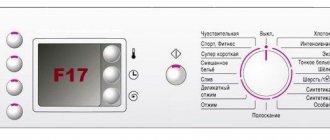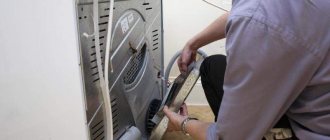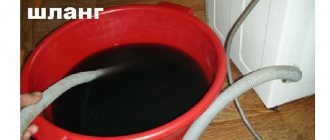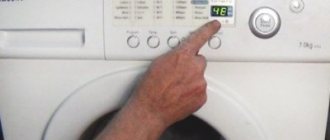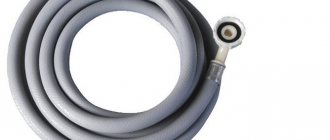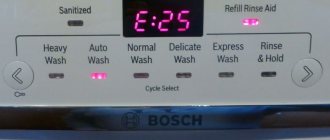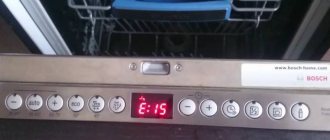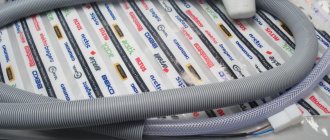Automatic washing machines are no longer a rarity; they can be found in almost every home today. But in order for the equipment to be convenient to use, and for it to work smoothly in the future, it is advisable to immediately install shut-off plumbing fittings into the system before connecting it. This function is provided by a faucet connected directly to the water supply. And in order to choose and buy the optimal and convenient option for yourself in the store, you must first become familiar with what these taps generally are.
Washing machine faucet: a necessity or a waste of money?
To connect the washing machine to water, it is not at all necessary to buy and install a special faucet. Direct connection is also possible. But is it worth doing this? Insignificant savings are fraught with large expenses.
The valve will be needed in a situation where you need to urgently shut off the water to the washing machine. Not installed? The likelihood of flooding the apartment and neighbors if a leak occurs is very high. In this case, you will have to spend more on repairing and restoring furniture than on purchasing a water seal.
Choosing a shut-off valve: main types
Today, a large assortment of all kinds of valves is offered for sale. Their position, as well as the number of pins, determines the type of device:
- Straight tap with two water outlets. Separates household appliances from the general communications system. It is attached to a separate pipe that runs from the central water supply to the unit itself.
- Water tap tee. Unlike double, it has three outputs (which is clear from the name itself). If necessary, the user can close one exit. The other two are flow-through and are used to connect the main pipe to the branch pipe. Tees can be of different shapes, with overlapping of one or two outlets at once.
- Angular. Used when installing an automatic washing machine in limited space (for example, in a very small bathroom), where it is not possible to install a standard straight-through tap. It is an improved, well thought out design with two outlets.
Angle valves are used to supply water not only to washing machines, but also to other equipment, including plumbing fixtures - toilet cisterns, bidets, etc.
Most often, manufacturers of washing machines recommend the types and types of components that should be used with the device. Washing machine installers advise you to listen to these recommendations.
Types of taps and their design
Washing machine taps are regular shut-off fittings. Manufacturers offer them in several modifications.
Material for making taps:
- High-quality fittings are made from brass. It is an alloy of copper with zinc and tin. The fitting is yellow in color and has a solid “metal” weight. Resistant to corrosion, impact, and has a long service life. Ball valves made of brass will outlast any washing machine.
- The market offers cheap analogues made in China. These are lightweight fittings made of white, shiny silumin alloy. The alloy consists of 90% aluminum with the addition of silicon.
We recommend that you read: How to choose a needle valve for a pipeline?
The choice is up to the owner, but saving on a piece purchase is unwise here.
The required configuration of the faucet for the washing machine is determined by its installation location. There are three types in total:
- Flow-through or pass-through. An end fitting that is installed on the head of a water pipe or on an individual pipe outlet to cut off equipment from the central pipe.
- Angle end valve. It will be needed if there is a need to rotate 90 degrees at the connection point. The most common option for installing such a valve is for the outlet for the washing machine to come out of the wall.
- Three-way or tee. The faucet combines the function of a tee and a shut-off device. It is purchased if it is necessary to integrate a washing machine into the common wiring, when connecting household appliances in parallel.
In retail chains, ask for special taps for washing machines if your installation option is an individual tap. Manufacturers produce them in walk-through and corner models.
Note! The difference between a special faucet for a washing machine and a regular shut-off fitting is in the size of the thread. The hose requires an external thread of ¾ inch, and the pipes require an internal or external thread of ½ inch.
According to the type of internal structure, all taps are divided into:
- ball;
- threaded
Ball valves are designed to completely shut off water in half a turn (half-turn). They are arranged as simply as possible:
- a body with a seat in which a ball with a hole rotates freely;
- locking ball;
- rotary rod with sealing rings;
- rotary handle in the form of a lever or butterfly;
- thread on the body for connection to the pipe and washing machine, can be external or internal.
A threaded or multi-turn valve is closed by moving the valve axle up and down along the thread. These fittings are designed to regulate the flow force and are not installed as a shut-off device for the washing machine. Theoretically, this can be done, but in practice it will be inconvenient to use such a crane.
We recommend that you read: Using paint for the surface of galvanized pipes
Why isn't a standard flow valve suitable?
Situations are not uncommon when users of washing machines have not encountered the supply of water to household appliances and do not understand why they cannot install a standard flow valve.
If you know what water hammer is, then such questions will not arise: water under high pressure literally breaks metal-plastic and even metal pipes. Is the washing device connected directly using a regular hose? There is a high probability that during a water hammer it will be torn into pieces.
A tee tap is most appropriate. It will not only withstand high pressure, but will also allow you to connect several different devices to the water at once. For example, a washing machine and a dishwasher.
Important points
When choosing a valve for your washing machine, consider:
- Material. Sellers offer faucets made of silumin or brass. The first option is very short-lived, although more attractive in price. Opt for the second one. Pay $1-2 more, but get a reliable shutter device.
- The design of the mechanism for overlapping. Multi-turn or ball are two possible options. Ball valves boast a long service life:
- Valve design. Its handle is used in emergency situations when you urgently need to turn off the water supply. It should be comfortable and not too small. Then you can turn off the water in a couple of seconds.
Pipe insertion
You can install the tap directly on the pipe, but this option is considered labor-intensive. It requires cutting out the area. Such work will not seem very difficult if the elements are made of plastic. Special scissors can handle this. Labor costs will increase if the pipeline is made of metal. In this case, you will have to take a grinder. To determine the size of the area that needs to be cut, you should add up the dimensions of the filter and the length of the tap. Next, you can arrange the incision. You will also need threads at the ends of the pipes. It should have the same parameters as the grooves on the tap.
The next stage is filter installation . It will protect the design of washing equipment from foreign impurities, which are often found in tap water. Next, install a tap for water supply. For this purpose, remove the mounting nuts used to connect to the pipe. If the structure is made of plastic, before proceeding, the part must be expanded with a calibrator. Installation of a tap with insertion is advisable when metal-plastic or polymer elements were used to produce the pipeline. Such a unit can be placed under the sink or in another place convenient for use. The joints must be secured using tension rings.
The inlet hose is connected to the tap compartment. After this, all that remains is to tighten all the existing nuts with an adjustable wrench. The clamping force during such work is especially important. If the bolt is not tightened well enough, the structure may be damaged. The same can be said about the situation when the fixing elements are overtightened. This may cause leakage. O-rings are used for sealing. They are usually included with the filter or faucet. Flax fibers can also cope with this task. Checking the finished structure is the final stage of the work.
Installation of SMA tap
Have you chosen a part of the desired shape, type and design? Wonderful! Proceed to install it yourself.
The process itself is quite simple. The main thing is to have patience, tools and additional parts. You will need:
- Double wall hose. Manufacturers include conventional single-wall filler hoses with the devices. Experts advise not to install them. The optimal solution is to spend money and buy a more reliable hose that has two walls and wire reinforcement.
When buying a hose, consider the length. Manufacturers often save money and include very short hoses in the kit.
- Water filter. It is attached to a branch of the pipe running from the water supply to the tap thread. Tap water is not of good quality. Is it possible to put 2-3 filters in front of the machine? Great! The principle of more is better works here.
- Accessories for sealing. All kinds of sealing elements are used to ensure high-quality connection of parts and prevent leaks.
How to install a washing machine
- Adjustable wrench. Needed for tightening nuts and seals.
Is everything you need at hand? Proceed by determining in advance the optimal connection diagram. The following options are possible:
Using a tee, cutting into a pipe
Follow the following instructions:
- Shut off the water in the riser.
- Cut the required length of pipe taking into account the length of the tee.
- Place the mounting nuts onto the pipe.
- Install the tee.
- Tighten the joints thoroughly with tightening rings.
- Connect the inlet hose to the drainage system.
Through a two-way tap
The circuit is used in cases where a separate tap has already been provided for the device. The latter must have a threaded bushing. All you have to do is screw the purchased faucet onto it, installing a filter in it in advance. Then connect the inlet hose.
Crane installation and equipment connection
Before you install the shut-off valve and connect your machine to it, there are a few things to consider. Is the quality of tap water suitable for safe use of equipment? If the water leaves much to be desired, purchase an additional filter. It will need to be installed in front of the tap.
Is the washing machine supply hose long enough to reach the connection point? If not, get a longer hose. Extending the length with a connection is prohibited. This design will quickly lead to leakage. The specialized hose is equipped with a filter, O-ring and coupling that fits perfectly into the tap.
End valve installation
Connecting to a ready-made outlet is not difficult. You will need an adjustable wrench and fum tape.
The procedure is as follows:
- We wrap the external thread on the faucet or pipe (depending on your design) with fum tape so that the faucet is screwed on with noticeable force.
- We screw the valve to the pipe, first by hand, then tighten it with a wrench.
- We connect the inlet hose of the washing machine by screwing the plastic coupling along the thread to the end.
- Open the installed valve and check the tightness of the connections.
We recommend that you read: How to make a chimney for a gas boiler?
The hose from the washing machine has a different configuration at the ends - angled and straight connections. Typically, the corner end is screwed to the washing machine. This makes it possible to install it close to the wall. The straight end is connected to the shut-off fitting.
Installation of a walk-through valve
There are several ways to install an outlet on a washing machine yourself without cutting the pipe:
- Install a walk-through tap into an existing outlet on a boiler, dishwasher or other object. The tee is placed in front of the already installed tap. The result is a design consisting of two side-by-side locking devices.
- Connect the washing machine in front of the faucet to the sink. To do this, you will need to disconnect the flexible faucet hose from the cold water supply. Install a pass-through tap for the washing machine onto the pipe. Connect the mixer to the tap, and the hose from the machine to the outlet of the tee.
- Connect the machine in front of the flexible water supply hose to the drain tank. The technology is the same as when connecting to a mixer.
Note! On the body of the walk-through faucet there is an arrow in the direction of water movement. The second point - before installation, try on the stroke of the valve handle.
The technology for installing a walk-through tap is no different from a conventional one. All threaded connections are sealed by winding fum tape onto the external thread. If you hold the thread towards you, then you need to wind it clockwise. This will prevent the tape from creasing when tightening the fitting.
It is important! Connecting a washing machine to a hot water supply is not recommended, since the quality of the water in the heating system (namely, where hot water is supplied from) leaves much to be desired. When washed with this water, laundry acquires a persistent yellow tint.
